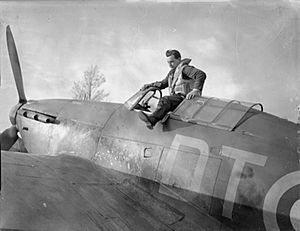Howard Blatchford facts for kids
Quick facts for kids
Howard Peter Blatchford
|
|
|---|---|

Flight Lieutenant H P "Cowboy" Blatchford of No. 257 Squadron RAF climbing out of his Hawker Hurricane Mark I at RAF Martlesham Heath, Suffolk.
|
|
| Birth name | Howard Peter Blatchford |
| Born | 25 February 1912 Edmonton, Alberta, Canada |
| Died | 3 May 1943 (aged 31) Amsterdam, German-occupied Netherlands |
| Allegiance | United Kingdom |
| Service/ |
Royal Air Force |
| Years of service | 1936–1943 |
| Rank | Wing Commander |
| Unit | No. 41 Squadron RAF No. 212 Squadron RAF No. 17 Squadron RAF No. 257 Squadron RAF Digby Wing Coltishall Wing |
| Battles/wars | World War II |
| Awards | Distinguished Flying Cross |
Wing Commander Howard Peter "Cowboy" Blatchford was a brave Canadian pilot. He was born on February 25, 1912, and sadly passed away on May 3, 1943. He was known as a "flying ace" because he shot down many enemy planes during World War II. He even achieved the very first victory for a Canadian pilot in that war.
Contents
Early Life and Joining the Air Force
Howard Peter Blatchford was born in Edmonton, Alberta, Canada. When he was 24 years old, in February 1936, he joined the Royal Air Force (RAF). This was the United Kingdom's air force.
In early 1937, he was sent to his first squadron, No. 41 Squadron RAF. A squadron is a group of military aircraft. Later, in April 1940, he moved to No. 212 Squadron RAF. Here, he flew planes that took pictures from the sky to gather information. This was called photo-reconnaissance.
Flying in World War II
As World War II continued, Blatchford joined the Photographic Development Unit in June 1940. He became a flight commander, which meant he was in charge of a group of planes. In September, he moved again, this time to No. 17 Squadron RAF, where he flew Hawker Hurricane fighter planes. Soon after, he joined No. 257 Squadron RAF, working under a famous pilot named Squadron Leader Robert Stanford Tuck.
Awarded for Bravery
In December 1940, Blatchford received a very special award called the Distinguished Flying Cross (DFC). This award is given for great bravery while flying.
Here is why he received it:
- In November 1940, he led his squadron.
- His squadron destroyed eight enemy aircraft and damaged five more in one day.
- During a fight, his plane ran out of bullets. He bravely rammed and damaged an enemy fighter with his own plane.
- After that, he made two daring fake attacks on enemy fighters, which scared them away.
- The award recognized his amazing leadership and courage.
Leading the Way
In July 1941, Blatchford became the commanding officer of No. 257 Squadron RAF. This meant he was in charge of the entire squadron.
He was promoted to Wing Commander in September of that year. This made him the "wing leader" of the Digby Wing. A wing leader is in charge of several squadrons. A famous poet and pilot, John Gillespie Magee, who wrote the poem "High Flight," joined a squadron at Digby around this time.
Blatchford completed his duty tour in April 1942. He returned to flying missions in February 1943 as the wing leader of the Coltishall Wing. On March 29, 1943, his plane was hit by anti-aircraft fire, but he landed safely. On April 4, 1943, while leading an escort mission for bombers, his plane was severely hit by an enemy fighter.
Final Mission and Remembrance
On May 3, 1943, Wing Commander Blatchford was leading the Coltishall Wing to protect bombers attacking a power station in Amsterdam. During this mission, his plane was shot down by an enemy pilot. He was killed in action, and his body was never found.
Howard Peter Blatchford is remembered at the Air Forces Memorial in Runnymede, England. This memorial honors airmen who died in World War II and have no known grave.
His Achievements
By the time of his death, Blatchford had achieved a remarkable record as a flying ace. He was credited with:
- Five enemy aircraft shot down by himself.
- Three enemy aircraft shot down with other pilots.
- Three "probables" (likely shot down, but not fully confirmed).
- Four enemy aircraft damaged.
- One enemy aircraft damaged with another pilot.

